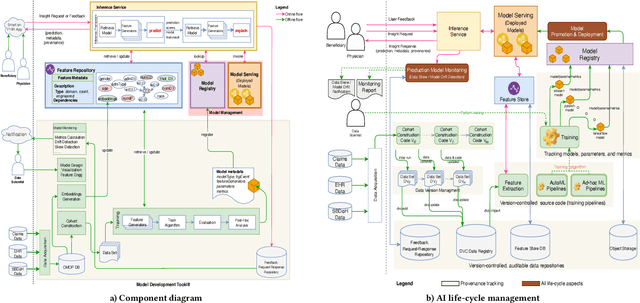Bhavani Iyer
Granite Embedding Models
Feb 27, 2025Abstract:We introduce the Granite Embedding models, a family of encoder-based embedding models designed for retrieval tasks, spanning dense-retrieval and sparse retrieval architectures, with both English and Multilingual capabilities. This report provides the technical details of training these highly effective 12 layer embedding models, along with their efficient 6 layer distilled counterparts. Extensive evaluations show that the models, developed with techniques like retrieval oriented pretraining, contrastive finetuning, knowledge distillation, and model merging significantly outperform publicly available models of similar sizes on both internal IBM retrieval and search tasks, and have equivalent performance on widely used information retrieval benchmarks, while being trained on high-quality data suitable for enterprise use. We publicly release all our Granite Embedding models under the Apache 2.0 license, allowing both research and commercial use at https://huggingface.co/collections/ibm-granite.
PrimeQA: The Prime Repository for State-of-the-Art Multilingual Question Answering Research and Development
Jan 25, 2023



Abstract:The field of Question Answering (QA) has made remarkable progress in recent years, thanks to the advent of large pre-trained language models, newer realistic benchmark datasets with leaderboards, and novel algorithms for key components such as retrievers and readers. In this paper, we introduce PRIMEQA: a one-stop and open-source QA repository with an aim to democratize QA re-search and facilitate easy replication of state-of-the-art (SOTA) QA methods. PRIMEQA supports core QA functionalities like retrieval and reading comprehension as well as auxiliary capabilities such as question generation.It has been designed as an end-to-end toolkit for various use cases: building front-end applications, replicating SOTA methods on pub-lic benchmarks, and expanding pre-existing methods. PRIMEQA is available at : https://github.com/primeqa.
Synthetic Target Domain Supervision for Open Retrieval QA
Apr 20, 2022



Abstract:Neural passage retrieval is a new and promising approach in open retrieval question answering. In this work, we stress-test the Dense Passage Retriever (DPR) -- a state-of-the-art (SOTA) open domain neural retrieval model -- on closed and specialized target domains such as COVID-19, and find that it lags behind standard BM25 in this important real-world setting. To make DPR more robust under domain shift, we explore its fine-tuning with synthetic training examples, which we generate from unlabeled target domain text using a text-to-text generator. In our experiments, this noisy but fully automated target domain supervision gives DPR a sizable advantage over BM25 in out-of-domain settings, making it a more viable model in practice. Finally, an ensemble of BM25 and our improved DPR model yields the best results, further pushing the SOTA for open retrieval QA on multiple out-of-domain test sets.
Learning Cross-Lingual IR from an English Retriever
Dec 15, 2021



Abstract:We present a new cross-lingual information retrieval (CLIR) model trained using multi-stage knowledge distillation (KD). The teacher and the student are heterogeneous systems-the former is a pipeline that relies on machine translation and monolingual IR, while the latter executes a single CLIR operation. We show that the student can learn both multilingual representations and CLIR by optimizing two corresponding KD objectives. Learning multilingual representations from an English-only retriever is accomplished using a novel cross-lingual alignment algorithm that greedily re-positions the teacher tokens for alignment. Evaluation on the XOR-TyDi benchmark shows that the proposed model is far more effective than the existing approach of fine-tuning with cross-lingual labeled IR data, with a gain in accuracy of 25.4 Recall@5kt.
End-to-End QA on COVID-19: Domain Adaptation with Synthetic Training
Dec 02, 2020



Abstract:End-to-end question answering (QA) requires both information retrieval (IR) over a large document collection and machine reading comprehension (MRC) on the retrieved passages. Recent work has successfully trained neural IR systems using only supervised question answering (QA) examples from open-domain datasets. However, despite impressive performance on Wikipedia, neural IR lags behind traditional term matching approaches such as BM25 in more specific and specialized target domains such as COVID-19. Furthermore, given little or no labeled data, effective adaptation of QA systems can also be challenging in such target domains. In this work, we explore the application of synthetically generated QA examples to improve performance on closed-domain retrieval and MRC. We combine our neural IR and MRC systems and show significant improvements in end-to-end QA on the CORD-19 collection over a state-of-the-art open-domain QA baseline.
A Canonical Architecture For Predictive Analytics on Longitudinal Patient Records
Jul 24, 2020
Abstract:Many institutions within the healthcare ecosystem are making significant investments in AI technologies to optimize their business operations at lower cost with improved patient outcomes. Despite the hype with AI, the full realization of this potential is seriously hindered by several systemic problems, including data privacy, security, bias, fairness, and explainability. In this paper, we propose a novel canonical architecture for the development of AI models in healthcare that addresses these challenges. This system enables the creation and management of AI predictive models throughout all the phases of their life cycle, including data ingestion, model building, and model promotion in production environments. This paper describes this architecture in detail, along with a qualitative evaluation of our experience of using it on real world problems.
 Add to Chrome
Add to Chrome Add to Firefox
Add to Firefox Add to Edge
Add to Edge